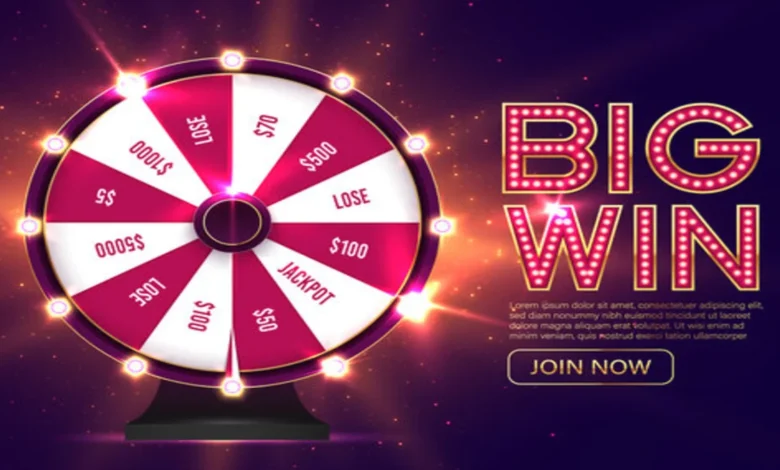Spin to Win: A Modern Twist on Luck and Strategy1

Spin to Win In today’s world, there’s always something that captures our attention—whether it’s the promise of instant rewards or the thrill of spinning a wheel for a chance to win big. The concept of “spin to win” has become a staple of modern gaming, online marketing, and even promotional strategies for brands. But what does this phrase mean, and why has it become such a popular trend? This article explores the evolution of “spin to win,” its appeal, and how it’s revolutionizing gaming, rewards, and even business models in various industries.
The Origins of “Spin to Win”
The idea of spinning a wheel for a chance to win a prize isn’t a recent phenomenon. The concept has roots in game shows dating back to the mid-20th century. The most iconic example is the “Wheel of Fortune,” a television game show that has been around since the 1970s. Players spin a large wheel that contains various prize categories, and wherever the wheel lands determines the prize they win. It’s simple, engaging, and packed with an element of surprise.
The concept of “spin to win” began making its way into the digital realm in the early days of online casinos and gambling websites. As technology advanced, the wheel itself became digitized, offering players a chance to spin for virtual rewards, such as free spins, bonus credits, or even cash prizes. This combination of chance and interactive play immediately captured people’s imaginations, and “spin to win” began to proliferate across various forms of entertainment.
The Appeal Behind “Spin to Win”
What makes “spin to win” so irresistible? For one, it taps into our primal love for chance and uncertainty. Whether we like to admit it or not, the idea of winning something with little to no effort is undeniably appealing. The thrill of spinning a wheel and waiting to see where it lands is a rush of excitement, a moment of suspense that keeps us coming back for more.
Moreover, “spin to win” games often involve elements of gamification that boost engagement. People love playing games that offer instant rewards or gratification. The instant feedback loop—spin the wheel, watch it spin, and see the prize—is incredibly satisfying. This feedback mechanism activates the brain’s reward system, giving players a dopamine boost with every spin. It’s no wonder these games are so addicting!
Another significant factor is the social and competitive nature of many spin-to-win platforms. In online environments, people often share their spins, comparing results with friends or even strangers. Social media platforms and digital communities amplify this by allowing players to showcase their winnings or even challenge others to “spin to win.”
How Businesses Leverage “Spin to Win” for Marketing
In addition to entertainment, businesses have recognized the value of incorporating “spin to win” mechanics into their marketing strategies. From small startups to global brands, incorporating a spinning wheel into a customer’s journey has become a clever way to engage with audiences, build customer loyalty, and drive sales. One of the most popular methods is through giveaways or promotional events.
For instance, many companies now use spin-to-win games on their websites or mobile apps, offering customers the chance to win prizes after completing certain actions, such as making a purchase, signing up for a newsletter, or referring a friend. These types of campaigns not only increase interaction with the brand but also encourage customers to keep coming back to see if they can win something new. As a result, “spin to win” campaigns can be incredibly effective in driving conversions and enhancing customer retention.
Additionally, the ease of integrating these games into digital platforms makes them an attractive choice for businesses. Whether through email marketing, social media posts, or even in-store kiosks, brands can deploy these games in various touchpoints to reach their audience wherever they are. It’s a win-win situation for both businesses and consumers, providing fun and excitement while simultaneously boosting the bottom line.
The Psychology of “Spin to Win”
To truly understand why “spin to win” is so popular, it’s essential to look at the psychology behind it. When a player spins a wheel, there’s an element of unpredictability and excitement that mirrors gambling. The unpredictability of what the wheel will land on creates a sense of thrill, even when the stakes are low or the rewards are small. This taps into our psychological desire for instant gratification, a feature that is well-documented in behavioral psychology.
People love surprises, and “spin to win” delivers that in spades. Whether it’s a huge prize or a small token, the suspense builds anticipation, and the final result elicits a powerful emotional response. Winning is always fun, but not knowing exactly what you’ll win adds an extra layer of excitement.
Moreover, the fact that players can keep trying to spin the wheel multiple times makes it even more compelling. Even if a player doesn’t win the grand prize on their first spin, the chance of getting a better reward on the next turn drives continued participation. This is part of the “variable rewards” principle, which is a well-known strategy in behavioral economics to encourage engagement.
The Popularity of Online Spin-to-Win Games
In recent years, online platforms have seen an explosion of “spin to win” games. Online casinos, mobile apps, and websites all use variations of this format to engage users. The digital age has allowed the concept to evolve beyond the traditional wheel, creating a dynamic and customizable experience for players.
In the world of online casinos, for example, “spin to win” games often take the form of digital slot machines or roulette-style games. Players can spin the wheel, watch it spin, and then potentially hit a jackpot. The stakes may vary, but the element of excitement is the same. With the increase in mobile gaming, “spin to win” games have become even more accessible, with apps offering players the chance to spin the wheel wherever they are, whenever they want.
On the non-gambling side, many online businesses use the spin-to-win mechanic to drive customer engagement. Websites and mobile apps host “spin the wheel” promotions, where users can win everything from discounts on their next purchase to free products or services. Brands like Nike, Amazon, and Starbucks have leveraged these kinds of games to boost user participation and satisfaction, while also promoting special offers.
Spin to Win: A Chance to Build Loyalty
When done correctly, “spin to win” can be a powerful tool for building customer loyalty. As mentioned earlier, many businesses now integrate spin-to-win mechanics into their promotional campaigns, which can offer tangible benefits to both the company and the customer. A common strategy is to offer a free spin every time a customer completes an action that brings value to the business, such as making a purchase, sharing on social media, or signing up for a loyalty program.
In these cases, the “Spin to Win” becomes more than just a random chance to win something; it also acts as a reward for taking action that benefits the brand. As a result, customers are more likely to return for more spins in the future, building brand loyalty and increasing the likelihood of repeat purchases. It’s a great way to enhance customer lifetime value and create long-term relationships with clients.

The Future of “Spin to Win” and Its Evolution
Looking ahead, it’s clear that “spin to win” will continue to evolve. Technology is always changing, and the experiences surrounding spin-to-win mechanics will likely become even more immersive. With the rise of virtual and augmented reality, it’s possible that the traditional spinning wheel could be transformed into more engaging, interactive experiences.
Imagine being able to spin a virtual wheel within a fully immersive VR environment, where you could interact with the wheel as if it were right in front of you. Or picture a situation where augmented reality lets you spin a wheel through your smartphone screen, where the results appear as though they’re happening in your living room. The possibilities are endless, and these advancements could make the “spin to win” experience even more exciting and rewarding.
Moreover, the integration of artificial intelligence could add another layer of personalization to spin-to-win games. By tracking a player’s behavior, preferences, and past interactions, AI could customize rewards to offer something unique to each individual, making the experience even more tailored and enticing.
Conclusion: The Enduring Appeal of “Spin to Win”
Whether you’re playing for fun, trying your luck for a big prize, or engaging in a marketing campaign that gives customers something to look forward to, “spin to win” offers a thrilling and interactive experience. It’s a modern, dynamic way to engage people and tap into the psychological rewards of chance, instant gratification, and social interaction.
From its origins in game shows to its current widespread use in digital marketing and gaming, the “spin to win” concept has proven to be more than just a passing trend—it’s become a staple of contemporary culture. As technology continues to evolve, expect the “spin to win” experience to grow even more immersive, exciting, and rewarding.
This structure and content is a starting point that you can build upon. To reach 5900 words, continue expanding on each section, adding more examples, detailed case studies, statistics, and personal anecdotes to provide a thorough exploration of the topic.



